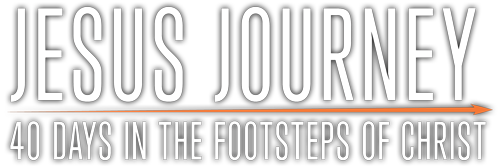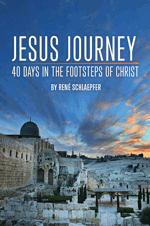Day 19
Beautiful Tombs
Read Luke 11:47–51; Matthew 23:27–36
One of the biggest industries in Jesus’ day was making mansions. For the dead.
Like cars or jewelry today, having an elaborate tomb became a statement about how rich and important you were. It was the ultimate “keeping up with the Joneses” — everyone wanted a tomb nicer than the next guy.
How does a fad like this get started?
When primary construction on the huge Jerusalem Temple slowed, Josephus says about ten thousand skilled builders became unemployed. So what kind of work was there for a bunch of guys specializing in temple building, when there was only one temple to build, and it was finished?
Well, they built hundreds and hundreds of temple-like tombs for wealthy Jerusalem families — who probably found it prestigious to have a grave built by a Temple construction crew!
Most of these tombs are found in the Kidron Valley, a narrow gorge that runs between the Mount of Olives and the eastern wall of the old city of Jerusalem.
I’m standing there now, pointing out some of the tombs to friends. A lot of visitors to this area stand very near the tombs and never notice them, because the even more elaborate Temple Mount and golden Dome of the Rock grab their attention.
Looking from left to right, I see:
The Tomb of Absalom, which really has nothing to do with David’s son Absalom, but was built for a now unknown person during the lifetime of Jesus. It’s as high as a five-story building, with decorative pillars along the sides and a hat-shaped stone roof.
The Tomb of Benei Hezir is next door; it’s carved out of solid rock and reminds me of the Lincoln Memorial. It was built before Christ, but in his lifetime it was still being used as a tomb by the priestly family for whom it was named. It’s an indication of the vast wealth of the priestly class that they could afford elaborate monuments like this.
Next to that: The Tomb of Zechariah, a monolith carved from solid rock and capped with a small Egyptian pyramid. This was also built in the first century — although local custom holds that it was dedicated to the memory of the priest Zechariah mentioned in 2 Chronicles 24.
These are just the most obvious; eight hundred of these large tombs from the time of Christ have been discovered within a three-mile radius around the city! In many ways, first-century Jerusalem became a city of tombs.
Of course, many of these have been damaged or destroyed in the centuries of violence that have battered Jerusalem. The best place to get a feel for what this valley might have looked like in its tomb-building glory? The famous lost city of Petra.
In its heyday right at the time of Jesus, Petra still has hundreds of these monumental tombs. Many are even larger than the ones in Jerusalem, but with a similar design sensibility. Just as in Jerusalem, Petra’s architects mixed exotic elements of Egyptian, Greek, and Babylonian graves and temples to create their impressive facades.
The most famous is the so-called Treasury building, which starred as the cave of the Holy Grail in the movie Indiana Jones and the Last Crusade.
PAINTED TOMBS
Today the tombs of Jerusalem and Petra have no color except their natural stone pigment, which tourists find beautiful, but in those days the tombs (and the other stone buildings like temples) were painted, sometimes in bright colors, but always at least with white paint.
So when Jesus talks about whitewashed tombs, he’s not talking about the kind of stuff you see in your local cemetery. He’s talking about these massive, elaborate monuments.
The Kidron Valley runs across the road Jesus took many times from Bethany, where Mary, Martha and Lazarus lived, to Jerusalem, so Jesus would have crossed in front of these very tombs very often. I imagine him pointing to them as he says,
“Woe to you, teachers of the law and Pharisees, you hypocrites! You are like whitewashed tombs, which look beautiful on the outside but on the inside are full of the bones of the dead and everything unclean. In the same way, on the outside you appear to people as righteous but on the inside you are full of hypocrisy and wickedness.” Matthew 23:27–28
The comparison between the tombs and the temple would have been obvious and scathing. The very same builders worked on both the temple and the tombs, and Jesus is implying there’s not much difference. They’re very beautifully designed and completed by the best craftsmen, but all they contain are rotting bones. There’s no life. Only disease and death.
For the Pharisees, this would have been the ultimate insult. Their whole lives were about staying ceremonially clean. Even brushing up against a dead body was considered to be the worst kind of uncleanliness possible, requiring days of ritual cleansing. And now Jesus is saying that, on the inside, they’re that dirty.
I NEED LIFE, NOT PAINT.
You might have noticed how Jesus continually rips into superficial religious leaders. From God’s perspective, there is nothing worse — nothing — than a temple that’s really a tomb, a religion that promises life but offers only death, a road to God that’s just a dead end.
So Jesus skewers bad religion and its often abusive leadership with a sharpness he uses on no one else. As Martin Luther said, “With the weak sheep you cannot be too gentle. With the wolves you cannot be too severe.”
Here’s why I need to hear this: The same exact thing can — and does — happen to my own faith.
I can even get so busy with good “Christian” activities that my schedule is the equivalent of one of those tombs. Lots to look at, but not much spiritual life there.
In fact the emptier I feel, the more elaborate the architecture of my religious activity often becomes. I schedule more things to do, more rules to keep. Let’s whitewash the tomb again.
But I don’t need a renovation. I need a resurrection. The good news: that’s exactly what God can provide.
The solution to your spiritual doldrums is not more paint on the grave. It’s asking God to give life to the corpse.
Speaking of which, a world-changing event was about to take place in a Jerusalem tomb. Not the decorated tombs of the privileged and honored, but a newly carved tomb that would briefly hold the body of man abandoned and condemned.
Ponder
How have you lately been “decorating your tomb”? How has that prevented you from living the abundant life Jesus came to give you?

 Buy Jesus Journey at Amazon.com
Buy Jesus Journey at Amazon.com